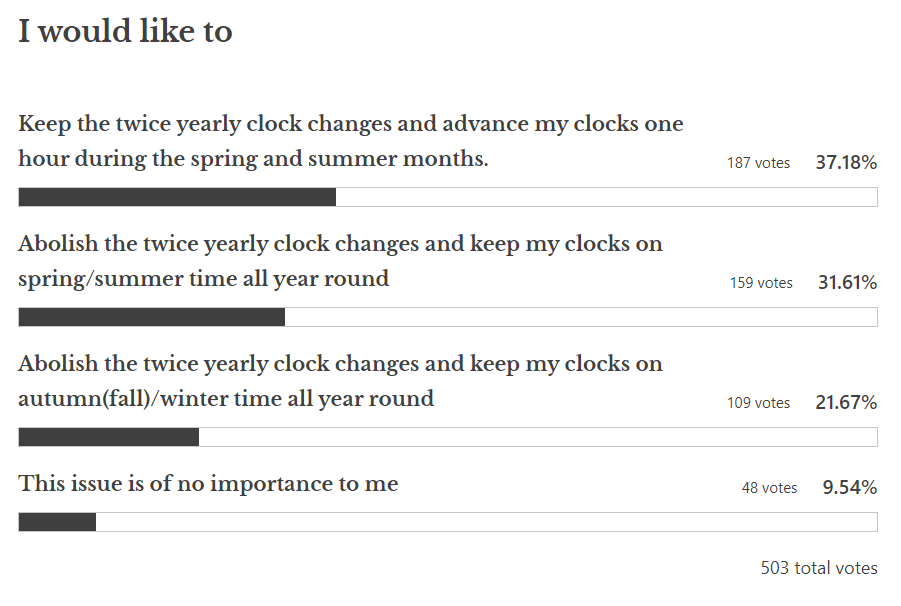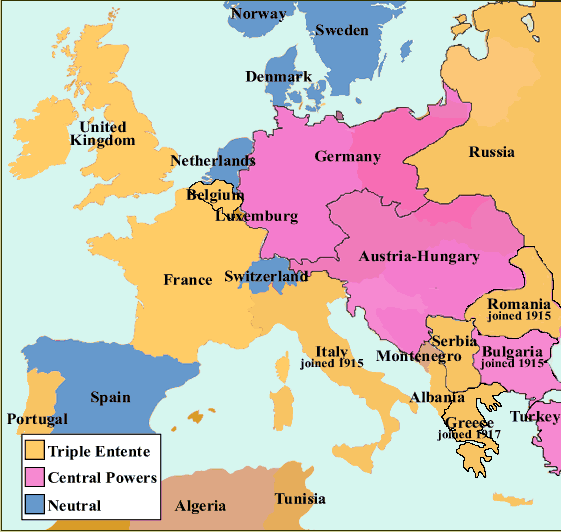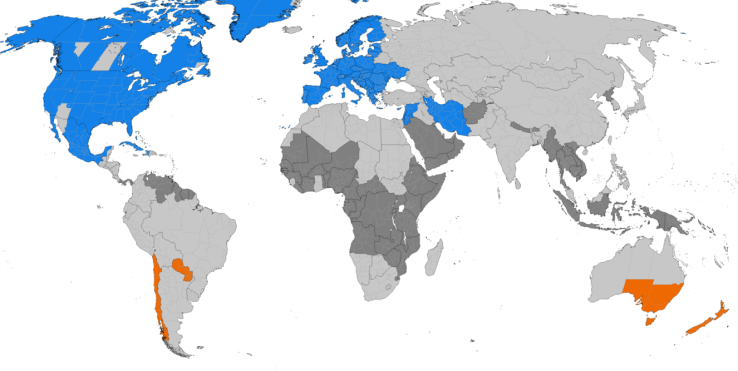Happy new year to all my readers!
Shortly after most of Europe and North America moved back to winter time from Daylight Saving Time, I created a poll to see how my readers living in these regions felt about the switch. Now that we’ve entered the new year, I’ve decided to close the poll and take a look at the results.
In total there were 503 replies and although I would by no means suggest that readers of my blog are typical of the public in general, the results are nevertheless interesting.

As you can see, none of the three options gained more than 50% of the vote. Although there is a clear majority for abolishing the twice-yearly task of advancing the clocks in spring and then putting them back in autumn(fall), there is no overwhelming majority for remaining on daylight saving time all year round. A substantial minority would like to remain on permanent winter time.
For additional background on the switch to Daylight Saving time here is part of a previous post on this topic
—————————————————————————————————————–
The beginning of DST
The first place in the world to practise DST was the town of Port Arthur, Ontario. In 1908, a local businessman, John Hewitson petitioned the town council to adjust the clocks one hour forward in the summer months so the locals could enjoy an extra hour of summer sun. The council agreed and the town turned its clocks ahead one hour from June to September.
DST became established in Europe and North America during the first world war. Two of the Central Powers (Germany and Austria-Hungary) adopted it in April 1916 followed by many European countries later that year. The US adopted it in 1918. The main justification for its use was that by having an extra hour of daylight in the evening, it reduced the need for energy in the stretched wartime economies.

Applying DST shifts the day. People lose an hour of daylight in the morning and gain an hour of daylight in the evening. Advocates of DST believe that the extra hour of daylight in the evening can be put to good use – allowing people to do outdoor activities in the evening with less need for artificial light. The hour of daylight lost in the early morning is of little importance, as it occurs before most people have started their daily activities. For example, on 21 June 2021, the Sun rose in London at 4:43 AM and set at 9:21 PM. If the UK didn’t observe DST it would have risen at 3:43 AM and set at 8:21 PM.
Supporters of DST claims it reduces energy usage for heating and lighting. Although this may have been true in the past, this benefit is now debatable. Modern light-bulbs are very energy efficient and, in many Southern states of the US, DST causes energy consumption to rise because it is slightly warmer in the evening – increasing the energy used on air conditioning.
The Decline of DST
Despite some of its proposed advantages, only one billion people live in a place which observes DST. In the map below the countries are coloured as follows.
- The areas shaded in blue observe Northern Hemisphere DST.
- The areas in orange observe Southern Hemisphere DST.
- The areas in dark grey have never observed DST.
- The areas in light grey used to observe DST (or permanent daylight saving where the clocks are advanced by one hour all year) but no longer do so.

Image from Wikimedia commons.
One disadvantage of DST is that the twice yearly clock shifts are disruptive to sleep patterns and need to be manually applied in many clocks, watches and some central heating timers. On the day of the change there can be disturbance to plans and people can arrive an hour late or early for appointments.
Another issue is that countries which observe DST do not change their clocks at the same time. For example, New York, like most of the US, puts it clocks forward at 2 AM (local time) on the second Sunday in March and back at 2 AM (local time) on the first Sunday in November. Whereas London, like the rest of the EU, put its clock forward at 1 AM (UTC) on the last Sunday in March and back at 1 AM (UTC) on the last Sunday in October. Therefore, for most of the year New York is five hours behind London, but there are two periods when the time difference is four hours. This can cause confusion e.g. when people try to arrange a transatlantic phone call in either of these periods.
A further complexity is that the small number of countries in the Southern Hemisphere which still use DST put their clocks forward at the start of their spring (which corresponds to the Northern Hemisphere autumn) and back at the start of their autumn (which corresponds to the Northern Hemisphere spring).
For example, if we consider Chile and New York, For five months of the year Chile is on the same time as New York. For roughly four and a half months Chile is two hours ahead and at other times one hour ahead. A recipe for confusion!
Data from https://www.timeanddate.com/time/change/chile
Recently, a number of countries have abolished the twice-yearly clock changes.
In 2011 Russia switched to permanent summer time. This was announced amid research claiming that changing the clocks caused Russians ‘stress and illness’. However, many Russians didn’t like very dark mornings in winter caused by having the clocks permanently advanced. For example, in Moscow, the sun didn’t rise until 9:57 AM on the date of the winter solstice. So, in 2014 Russia switched to permanent winter time to bring the civil time more in step with the solar time. Belarus, which has close political and economic ties with Russia also stopped the twice-yearly clock changes in 2011, but unlike Russia remains on permanent summer time (UTC+3).
Other populous countries which have recently abolished DST include:
- Turkey (population 86 million) in 2018
- Argentina (population 46 million) in 2009.
- Brazil (population 215 million) in 2020
- China (population 1.44 billion) in 1991.
- Iraq (population 42 million) in 2007.
- South Korea (population 52 million) in 1988.
- Uzbekistan (population 33 million) in 1991.
For more details see (https://www.timeanddate.com/time/dst/statistics.html )
Attempt to abandon DST in the EU

On March 26, 2019, the European Parliament voted in favour of backing the EU Committee draft directive to stop the one-hour clock change in the European Union. This was widely reported in the press at the time e.g. https://www.bbc.co.uk/news/world-europe-47704345 and was supposed to be implemented in 2021. It followed an EU-wide public consultation in 2018 which showed 84% of respondents wanting to scrap the biannual clock changes. However, the public consultation was poorly publicised and I, like the vast majority of UK citizens, was unaware it was taking place. In fact I have yet to meet anyone who aware of the consultation!
In total only 4.6 million people (less than 1% of EU population) expressed an opinion. If the proposal had been adopted each country in the EU would have to have decided whether to remain on permanent summer time or permanent winter time. However, it needs the agreement of the EU member states and I suspect it won’t be implemented for some time
One stumbling block was that the abolition of DST is opposed by most people in the Republic of Ireland. Shortly after the announcement the Irish government said they would oppose the change. The Irish objection is because the UK (which includes Northern Ireland) has no plans to abolish the twice-yearly clock changes. This would mean that, regardless of whether Ireland opted to remain on permanent winter time or permanent summer time, Northern Ireland and the Republic of Ireland would be on different time zones for approximately half the year. To many in Ireland this is unacceptable.
The Future of DST in the USA.
At present the US has no plan to abolish DST. Although individual states are allowed to opt out and remain on permanent winter time. At the moment, Hawaii and Arizona are the only states which do so. Interestingly, states are not permitted to remain on permanent year-round summer time. In 2014 a poll of around 1000 American adults found that only a minority (33%) were in favour of the clock changes, 48% were against and the remainder unsure.
However, at the moment, there is no strong nationwide push to abolish DST
DST in the Future
DST is falling out of use and now out of the 7.8 billion people in the world only one billion live in area where it is observed. If the EU does eventually abolish DST, this figure will reduce to half a billion. I think that it is very likely that in the next twenty years DST will fall into disuse throughout the world. Perhaps, in fifty years time, people will look back on DST as an arcane activity practiced in the twentieth and early twenty-first century.



[…] Happy New year 2022 […]
LikeLike
[…] Source link […]
LikeLike
I vote to keep what’s called “Daylight Saving Time” in California, USA. I can’t see that happening, but I vote for it anyway.
LikeLike
Hi Steve – I love your posts – as a fellow scientist I applaud you! Please keep up the good work! I wish I could do what you are doing! It’s really very important, as we (scientists) all know. Thanks, Paul R. Bowden, from Nottingham, in England
LikeLike
Thank you Paul.
Happy New Year!!
LikeLike
Driving north/south in Indiana in the US can be confusing and disruptive. You frequently have to stop and reset your watch. Even the phones get confused. 🙂
https://www.timetemperature.com/tzus/indiana_time_zone_map.shtml
LikeLike
Definitely a recipe for confusion.
I wonder why the entire state isn’t in the same time zone?
LikeLiked by 1 person
Happy New Year, Steve!
I don’t remember a survey in the UK either.
As you say, your own survey is scarcely conclusive, but it’s more so than those ridiculous surveys that many cosmetic companies do on TV! 🙂
LikeLike
Thank you Andrew. Happy New Year to you too!!
LikeLike
[…] This poll is now closed. To see the results click here […]
LikeLike